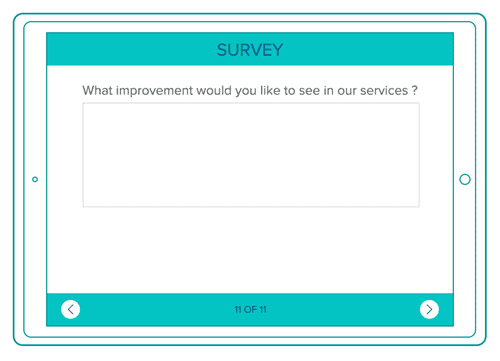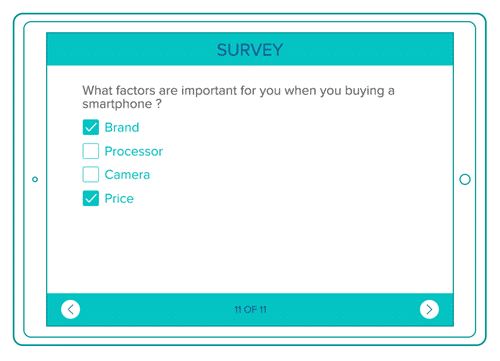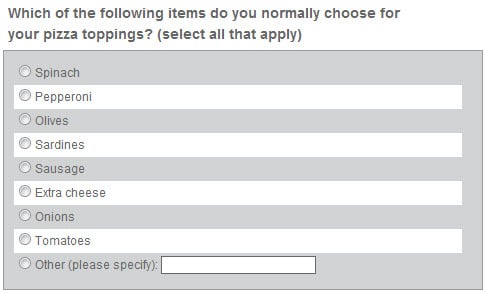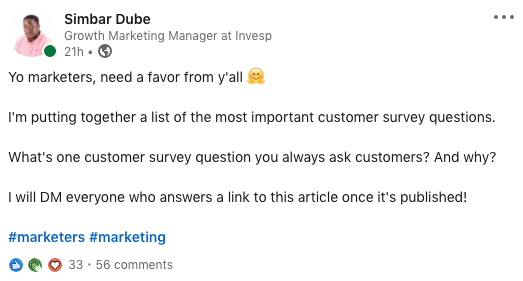Talk to your customers.
I have seen that statement being tossed around by different marketers on social media.
It’s probably one of the most common pieces of marketing advice today.
Sometimes I think it’s half-baked advice because it leaves me with questions like:
What should I talk to customers about?
Or what should I ask them?
Don’t get me wrong, I’m all for keeping in touch with customers and building valuable relationships with them.
But if you’re to advise me to talk to customers, at least give me directions of exactly what I should ask them.
Here’s the thing, talking to customers is easy – anyone can do it.
Being able to glean quality feedback and insights after talking to them is the challenging part.
Not everyone can pull it off.
But since you are smart enough to be reading this article, I won’t let you leave empty-handed. I will show you the different types of customer survey questions you can ask and 40+ survey question examples used by marketers today.
Five Types of Survey Questions
Survey questions are not all the same. They differ depending on the type of information you want to get from your customers. So, before we take a deep dive into 20 customer survey question examples, let’s by looking at the six different types of questions:
- Open-ended questions
- Closed-ended questions
- ‘Yes’ or ‘No’ questions
- Nominal questions
- Ratio scale questions
Open-ended questions
An open-ended question is a type of question that can be answered anyhow. In other words, it’s open to any answer. In the context of a survey, an open-ended question doesn’t limit users to one or two-word answers.
ALSO READ: Writing open-ended and closed-ended questions for user research
Users usually open up and feel more comfortable when a question is an open-ended one.
Examples of open-ended questions:

So how do you come up with an open-ended question?
Well, the way you will word your question is what will make it an open-ended question. If you want your question to motivate users to give you a detailed answer or a practical open-ended question, you should use words like how what, can, and why.
Such words in your question will give your users freedom to say more and reveal some insights that can be a game-changer in your conversion optimization efforts.
Closed-ended questions
A closed-ended question is a type of question that leaves no room for respondents to give a detailed answer. Most closed-ended questions have predefined, precise, and clear-cut answers.
In the context of a survey, closed-ended questions are ideal if you are looking for specific, simple, and direct answers. Closed-ended questions usually come with a set of pre-selected answers.
Here’s an example of a closed-ended question:

From the above example, you can see that participants are given only four options. They are not allowed to come up with an answer outside the set of predefined responses.
The only caveat with closed-ended questions is that respondents are only expected to choose from a set of predefined answers and are restricted from expressing themselves.
Yes or No Questions
Just like closed-ended questions, ‘yes’ or ‘no’ questions are also straightforward. In the field of linguistics, yes or no questions are also known as polar questions or general.
When asked a yes or no question, respondents will either affirm the question or deny it.
Examples of yes or no customer survey questions:

- Did you find what you were looking for on this website?
- Is there anything stopping you from making a purchase?
- Was this video helpful?
These questions come in handy when you want to collect information swiftly from your users. It takes less than 12 seconds to read the question and to either click on yes or no. So more people are inclined to answer this question.
Nominal Questions
This type of survey question allows respondents to select an answer from multiple options. Nominal questions are usually not numerical in nature, and they only overlap when you include a “both” or an “all of the above option.”
Examples of nominal survey questions include:

Here are more examples:
What’s your job title?
- Growth Marketer
- Head of Marketing
- Chief Marketing Officer
- VP of Marketing
- Other (please specify)
What kind of device are you using?
- Phone
- Tablet
- Desktop
- Other (please specify)
Suppose the provided options of a nomial question does not match the respondents’ accurate answers, you can use open-ended aspects like adding Other (please specify).
Rating Scale Questions
Rating scale questions are also known as ordinal questions. When answering a rating scale question, users are expected to choose one number that best represents their response. All answer options are displayed on a scale ranging from 0 to 100 or 0 to 10.
Examples of ratio scale questions:

- On a scale of 0-10, how was your experience using our website?
- How likely are you to recommend our product to your friends on a scale of 0-10?
As you can see from the above example, Net Promoter Score questions are an excellent example of ordinal or rating scale questions. When asking rating scale questions, it’s essential to let the respondents know about the value of every number on your scale.
40+ Customer Survey Questions That Marketers Love
Knowing how much marketers love asking questions, I reached out to them via LinkedIn and Twitter and asked them about their favorite customer survey questions.
Guess what?
They heed the call, and I got more than 50 thoughtful, open-ended customer survey questions:

Some of the questions are really good for eCommerce websites, some for SaaS, and others for blogs.
So, without further ado, here’s a list of 50 surveys question examples that you can ask your customers today.
1. What prompted you to search for X solution today? (Helps you know about their pain points).
2. How do you describe [product] to your colleagues? (Helps with messaging.)
3. If you could change ONE thing about [product], what would it be? (Helps with product development.)
4. Open your Screen Time iPhone app… What are the top 3 apps you spend most of your time on?” (Helps you find out where customers spend their time online.)
5. What prevented you from discontinuing the trial? (Helps you know the hurdles they are facing).
6. If you could provide any advice on how we can market this to people who struggle with [problem] or who need [solution], how would you go about it? (Helps you know about the language used by customers to describe your product).
7. What is the main reason you were unable to complete your purchase today? (Helps you know the hurdles they are facing).
8. What almost stopped you from buying today? (Tells you the objections/issues that the non-buyers most likely faced.)
9. What is the thing that frustrates you the most about (my product category)? (Helps you know about the conversion roadblocks faced by potential buyers)
10. Does this product help you achieve your goals? (Helps you know about the job that your product is hired to do)
11. How often do you use the product?
12. Which options did you consider before buying the product? (Helps you know about direct and indirect competitors).
13. How long have you been using the product?
14. What would you improve if you could?
15. What was happening in your business/life (B2B vs. B2C) that made you realize you need help with [problem]/you need to seek out [solution]? (helps you find out about drivers/triggers that made a customer make a purchase).
16. What of the following does your business need? (from Copyhackers): a.) more of XY b.) better quality of XY? (make them stop chasing the quantity and focus on quality, which delivers results; e.g., more leads vs. better leads ready to buy)
17. What are, in your opinion, the 3 most frustrating parts/situations of trying to [solution category]? (you know what to address in a copy, handle objections proactively) – here, you are aiming for emotion, so your copy doesn’t fall flat
18. Please complete the sentence using the phrase that first pops up in your head: “I need this [solution] ____________.” (You can get the most surprising answers that can help you build your copy)
19. Before using (your product name), what were you using before? (Helps you know about your direct and indirect competitors)
20. How likely are you to recommend our product to a friend?
21. What solutions did you consider? (If the purchase was recent, you might get good and real answers)
22. Where do you continually learn about your industry?
23. When buying this product or purchasing from this brand, how does it make you feel?
24. Tell us what you know now about [product/service] that you didn’t understand when you bought it and that if you had understood, you would’ve signed the deal much faster.
25. What was the thing that almost prevented you from buying? And how did you overcome it?
26. Would you replace what you buy now with (your product name)?
27. How does (your product name) make your life better?
28. How are you personally better off because of it? (follow up to question 27)
29. If you could wave a magic wand and change anything – it doesn’t matter if possible or not / about [problem area], what would it be. (Allows people to think outside of the box)
30. If the product was a person, what words will you use to describe it? (Helps to nail down the product’s brand identity and see if you are communicating the right kind of narrative in your marketing.)
31. What were you hoping this [your product/service name] would help you achieve? (Helps you understand the progress that your customers are trying to make using your product).
32. And how did we match up to those expectations? (follow up to question 30).
33. If this product wasn’t available, what would you have bought instead? (Helps you identify direct and indirect competitors).
34. How would you describe {name of your product} to a friend? (Gives you some idea of sentiment and helps you capture their language and see how they position you vs. how you do.)
35. What’s the first thing that comes to mind when you think of our brand? (let’s you know what your customers think of when your brand crosses their minds)
36. How does (your product name) make your life better? How are you personally better off because of it?
37. What’s the most important [topic] challenge you’re trying to solve this year?
38. How did you find out about (your product name)? (Helps you know how your marketing channels are faring, and it also helps you decide where you should focus more of your efforts.)
39. How would you feel if you couldn’t use (name of your product) anymore? (Helps you identify emotional connections that customers have with your brand)
40. Tell me in detail about the last time you went shopping for category x? (This should be a good reality check on how consumers, “actually” think about your category / brand / product.)
41. What other alternative solutions have you considered besides (your product name) in order to solve problem Y? (Helps you position your product against alternatives)
42. What made you choose (your product name) over the alternative solutions mentioned above? (follow up to question 41)
Important tip: Use questions that start with “are you the type of person who…” because people are more likely to engage with something that gives them a chance to express and validate themselves.
Conclusion: Not all customers have the proper feedback
Here’s a shocker:
Some of the problems you are facing at your company right now can be solved by simply asking your customers the right questions. I’m not by any means suggesting that customers always have the correct answers to all of your problems. But all I’m saying is you have a higher chance of creating an aha moment when you’re talking to your customers than when you’re trying to figure things out on your own.



